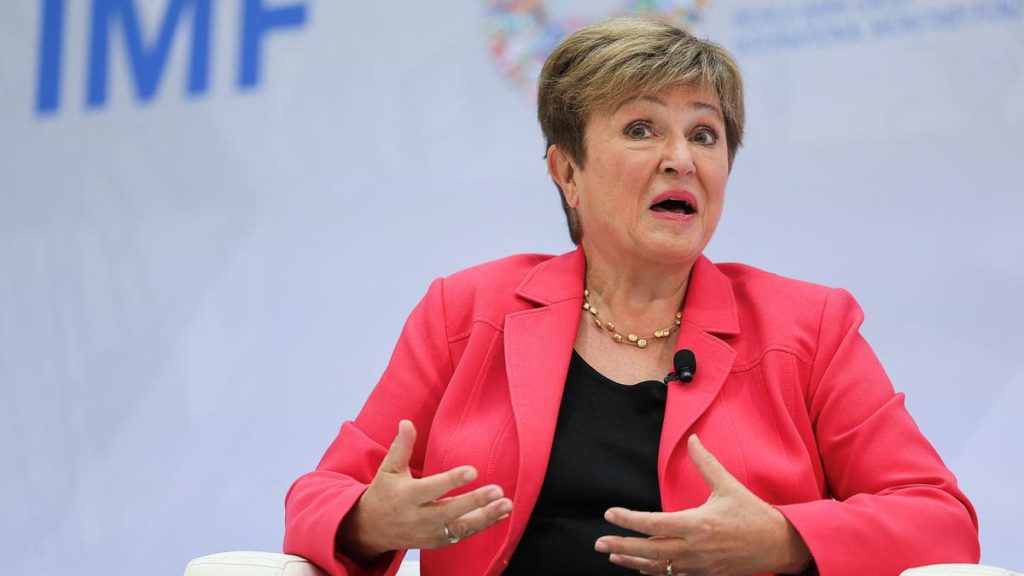
IMF MD Kristalina Georgieva speaks ahead of the IMF/World Bank Spring Meetings, at the IMF headquarters in Washington, D.C., U.S., on April 17, 2025.
| Photo Credit: Reuters
On the eve of its Spring Meetings, the International Monetary Fund (IMF) called on countries to find a settlement on trade issues, which it said was the top priority for a multipolar world. The IMF’s new growth projections, which will be released on Tuesday (April 22, 2025), would forecast “notable markdowns” in growth and inflation markups for some countries, but they would not forecast a recession, IMF Managing Director Kristalina Georgieva said on Thursday (April 17, 2025), days ahead of the World Bank’s and IMF’s first gathering since U.S. President Donald Trump returned to the White House and announced global tariffs on goods entering the U.S.
“In trade policy, the goal must be to secure a settlement among the largest players that preserves openness and delivers a more level playing field,” Ms. Georgieva said at a curtain-raiser event, where she called for restarting a global trend of lower tariff rates while reducing non-tariff barriers to trade.
During a question answer session following her remarks, Ms. Georgieva praised parts of Mr. Trump’s agenda and outlined silver linings to the gathering clouds of trade disruptions.
Also Read | WTO slashes 2025 trade growth forecast, warns of deeper slump
The IMF chief said Mr. Trump’s plan for deregulation would be “valuable” for the U.S. and create a “fertile environment” for businesses to succeed.
Bilateral trade negotiations that could follow the current uncertainty might result in countries that did not normally trade with each other to engage in trade, Ms. Georgieva said.
In some instances, tariff barriers could actually go down, she said, citing India as a potential example.
The U.S. President has taken on those who have criticised him personally or have attacked his policies and he has withdrawn the U.S. from a number of multilateral bodies and agreements that he believes treat America unfairly. In her remarks, Ms. Georgieva appeared to be making a case for why the IMF was helpful to the U.S.
“We don’t ask taxpayers for money,” she said, adding, “we operate like a savings account.”
“The United States in the last two years got $3.1 billion in interest payments for the money we lend,” she said.
India is reducing tariff and non-tariff barriers
Discussing where growth was expected in the context of a global slowdown, Ms. Georgieva identified Argentina, which has come out of a recession, India and Ukraine.
“India … very interesting in the context of the discussion we have around trade, a country that for quite some time was uneasy with reducing tariff and non-tariff barriers. India is now doing it,” she said, adding that this, along with increasing digitisation was creating the conditions for private sector investment and removing “self- inflicted injuries to growth”.
During her remarks, Ms. Georgieva said financial market volatility had increased and trade policy uncertainty was “literally off the charts”, as she pointed to a graph on a screen behind her.
“Uncertainty is costly,” she said, adding that rising trade barriers would hit economic growth, with protectionism eroding productivity over the long term, especially for smaller countries.
Countries must work extra hard to “put their own houses in order”, which for most countries would mean taking fiscal action to rebuild policy space, according to Ms. Georgieva.
In her remarks, the IMF chief encouraged emerging market economies to preserve exchange rate flexibility as a shock absorber. A depreciated dollar and rising U.S. Treasury yields should be seen as a warning, she said.
Without referring to any country by name, Ms. Georgieva said many blame the international economic system “for the perceived unfairness in their lives” and that tariff and non-tariff barriers had fed negative perceptions of the multilateral system. The convergence towards a low and stable U.S. effective tariff rate had stopped, she said, and non-tariff barriers were on the rise.
Ms. Georgieva also pulled up a chart of the U.S. effective tariff rate – now at levels “last seen several lifetimes ago”. She warned that although imports were a small proportion of GDP for the world’s three largest economies, the U.S., China and the E.U. , these were the world’s largest importers and their actions mattered, leaving smaller economies caught in the crosscurrents.
Published – April 17, 2025 10:10 pm IST

